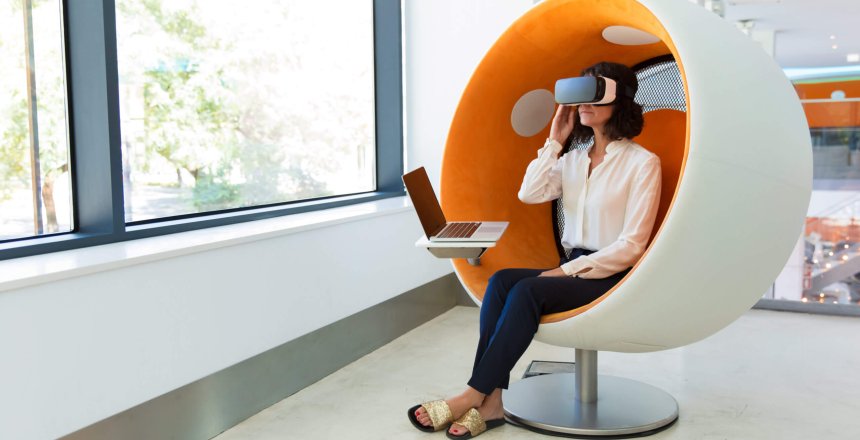Two years ago we’d never uttered the words ‘hybrid working’. Hybrid cars, sure. We spoke about agile working, flexible working, informal working arrangements, compressed working, I am sure I have missed a few but you get the drift.
Suddenly, it’s on everyone’s lips, and it’s how many of us are now working. But what does it mean and is it actually a better way of working?
Hybrid working
For most of us, hybrid is the link between fully in the office vs fully at home. It’s the mix of both worlds, allowing us to choose a blend of office and home (or virtual) working.
At its core, hybrid working should be from us taking all the best elements of being in an office together – to collaborate, socialise, enable spontaneous happenings, learn etc – combined with the best bits of wfh – flexibility in worklife balance, less stress, more focused quiet time etc. Enhanced employee experience is certainly one of the most positive outcomes of hybrid working, where people feel like they have a greater opportunity to be open about their whole self and address more of their personal commitments around delivering their work.
In order to maximise the benefits of hybrid working companies do need to adopt a new approach and think differently to how, when and where work is delivered and being very clear about their near and longer term strategic objectives.
Hybrid with structure
There are a number of options businesses have taken when it comes to hybrid working, with mixed results.
A free for all, meaning, it’s completely up to the individual what they choose in regards to number of days in the office vs number of days working virtually. This might work for some companies but has seen a rise in a culture of ‘them and us’ where it’s reported that many under 30s are choosing to work remotely whilst the over 30s are choosing to come into the office.
Another option is a team based approach, where as a team you decide when you’re going to be in the office or not. This works well when the office space allows for multiple collaboration areas and when teams have a coordinated approach to their cross team interdependencies. Occasionally issues arise when teams don’t communicate effectively with each other and their codependents are not in the office on the days when they’re in. It can also start to cause issues for teams who are in the office more regularly than others.
One approach that seems to be working well, is where we’ve seen companies putting in some structure around a centralised (leadership) decision to working in the office with a distinct purpose for what the office is used for. They are trialling new ways of working and technologies; such as fully moveable walls, electronic whiteboards, interactive screens, open plan areas, collaborative spaces, social spaces. And, making the most of getting people into the office so that people are not just coming in to sit staring at their screen all day.
The ideal number of days in the office needs to be trialled, what might work for some businesses might not work for others. Generally speaking, 2-3 days in the office is working well for those businesses that have taken the centralised option. It requires a more strategic view of what the purpose of the office is and working through questions like
- What is the purpose of the office for our teams (e.g. collaboration, social connection, fun, learning, communicating)?
- What is the work that is better done in the office?
- What work is best done virtually?
- How do you ensure inclusivity and equality?
- How do you avoid an ‘us and them’ culture (those who go to the office and those that don’t)?
- How do you remove any unconscious bias for those in the office and those out of the office?
- What forms of communication do you have in place to convey a common message?
- How are you recognising and rewarding people?
- What have been our greatest learnings from working virtually?
Discussing these questions with leaders and their teams will help inform and develop experiments to test and learn from. Be sure to factor in review and feedback sessions to make necessary adaptations and changes.
It’s a mindset shift
It’s not just a structural approach that is required. Hybrid working is about a mindset shift. It requires a culture of test and learn, which is similar to that of an agile mindset, to help build a more resilient organisation. Seeing the near-term changes as variable and certainly not the fixed option for how work will continue in the longer term. Setting some very clear goals and objectives for the near term and how they fit into the longer term business vision helps employees to understand what their contribution is and how their work supports the organisational goals. It helps with purpose and can provide an additional layer to support the type of work and where that is best delivered for individuals and teams.
Agile thinking requires leaders to be supportive and vulnerable – admitting that they don’t have all of the answers, and remaining open to change through listening to what is working and what is not. Leaders need to create a culture of delegation and being able to coach people through change so that everyone has the ability to test and learn, without fear of reprimand. This continuous learning approach will only help to nurture organisational resilience.
Tackling social connection
As a result of everyone having to work from home there has been a significant increase in people feeling a lack of connection with their work colleagues. For anyone who has ever read an engagement report, trust and support at work are significant determinants of engagement at work. Trust and support comes hand in hand with having social relationships with the people you work with. The more companies can do to address social connection, the greater engagement, and in-turn performance, will be. Companies need to keep an open mind about trialling and developing hybrid social opportunities. Creating the opportunity for people to contribute to what these social events might look like through employee forums, open chat sessions, reverse town halls and regular check-ins will enhance more creative ideas to test.
Organisational resilience
For now, being adaptable to change continues to be of upmost importance as we navigate the uncertainty and impact of Covid for the foreseeable future. Organisational resilience depends on an agile mindset and one that allows for constant innovation, testing and learning.
We have a suite of manager training to support managing hybrid teams, creating greater team connection and addressing team wellbeing. Get in touch with Bernadette bernadette@rosbyconsulting.com to find out more.




